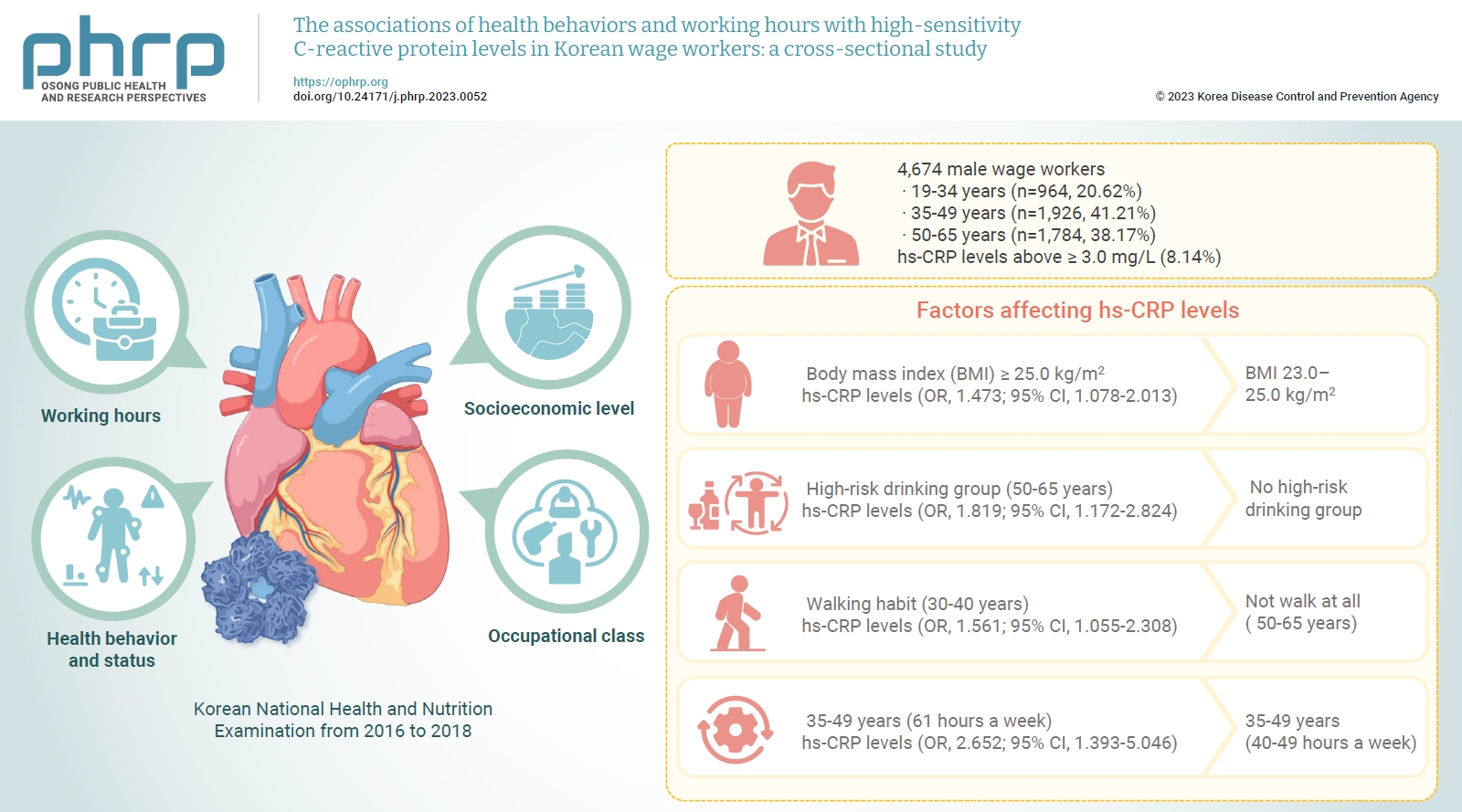Search
- Page Path
- HOME > Search
Original Articles
- The associations of health behaviors and working hours with high-sensitivity C-reactive protein levels in Korean wage workers: a cross-sectional study
- Choong-Won Seo, Eun-A Park, Tae-Hyung Yoon
- Osong Public Health Res Perspect. 2023;14(5):356-367. Published online September 21, 2023
- DOI: https://doi.org/10.24171/j.phrp.2023.0052
- 1,623 View
- 47 Download
-
 Graphical Abstract
Graphical Abstract
 Abstract
Abstract
 PDF
PDF 
- Objectives
We investigated differences in high-sensitivity C-reactive protein (hs-CRP) levels by age group according to working hours, socioeconomic level, health behavior and status, and occupational class, and aimed to identify factors affecting hs-CRP levels in various age groups using data from the Korean National Health and Nutrition Examination from 2016 to 2018. Methods: The study included a total of 4,786 male wage workers across the nation, aged between 19 and 65. Data from 4,674 workers were analyzed using multiple logistic regression analysis. Results: Obesity, metabolic syndrome, and weekly working hours were associated with hs-CRP, a biomarker of inflammation. Participants with a body mass index (BMI) ≥25.0 kg/m2 showed significantly higher hs-CRP levels than those with a BMI 23.0 to 25.0 kg/m2. Workers with high-risk drinking and metabolic syndrome showed significantly higher hs-CRP levels in the 50 to 65 years group. Obesity, walking 0 to 149 min/wk, and working ≥61 hours a week were associated with significantly higher hs-CRP levels in the 35 to 49 years group. The factors that significantly affected hs-CRP levels were different among age groups. Conclusion: Plans to adjust working hours should be considered health behaviors, such as drinking and physical activity, and health conditions, such as metabolic syndrome and obesity, according to workers’ age.
- The effect of photodynamic therapy using Radachlorin on biofilm-forming multidrug-resistant bacteria
- Choong-Won Seo, Young-Kwon Kim, Jeong-Lib An, Jong-Sook Kim, Pil-Seung Kwon, Young-Bin Yu
- Osong Public Health Res Perspect. 2022;13(4):290-297. Published online August 10, 2022
- DOI: https://doi.org/10.24171/j.phrp.2022.0150
- 2,114 View
- 45 Download
- 4 Web of Science
- 4 Crossref
-
 Abstract
Abstract
 PDF
PDF - Objectives
This study aimed to test the effect of photodynamic therapy (PDT) on the inhibition and removal of biofilms containing multidrug-resistant Acinetobacter baumannii.
Methods
Using multidrug-resistant A. baumannii strains, an antibiotic susceptibility test was performed using the Gram-negative identification card of the Vitek 2 system (bioMérieux Inc., France), as well as an analysis of resistance genes, the effects of treatment with a light-emitting diode (LED) array using Radachlorin (RADA-PHARMA Co., Ltd., Russia), and transmission and scanning electron microscopy to confirm the biofilm-inhibitory effect of PDT.
Results
The antibiotic susceptibility test revealed multiple resistance to the antibiotics imipenem and meropenem in the carbapenem class. A class-D–type β-lactamase was found, and OXA-23 and OXA-51 were found in 100% of 15 A. baumannii strains. After PDT using Radachlorin, morphological observations revealed an abnormal structure due to the loss of the cell membrane and extensive morphological changes, including low intracellular visibility and small vacuoles attached to the cell membrane.
Conclusion
PDT involving a combination of LED and Radachlorin significantly eliminated the biofilm of multidrug-resistant A. baumannii. Observations made using electron microscopy showed that PDT combining LED and Radachlorin was effective. Additional studies on the effective elimination of biofilms containing multidrug-resistant bacteria are necessary, and we hope that a treatment method superior to sterilization with antibiotics will be developed in the future. -
Citations
Citations to this article as recorded by- Photophysical properties of Radachlorin photosensitizer in solutions of different pH, viscosity and polarity
A.V. Belashov, A.A. Zhikhoreva, I.A. Gorbunova, M.E. Sasin, Sh.S. Shayakhmedov, I.V. Semenova
Spectrochimica Acta Part A: Molecular and Biomolec.2024; 305: 123480. CrossRef - Applications of Antimicrobial Photodynamic Therapy in Aquaculture: Effect on Fish Pathogenic Bacteria
Edith Dube, Grace Emily Okuthe
Fishes.2024; 9(3): 99. CrossRef - Understanding the biofilm development of Acinetobacter baumannii and novel strategies to combat infection
Naji Naseef Pathoor, Akshaya Viswanathan, Gulshan Wadhwa, Pitchaipillai Sankar Ganesh
APMIS.2024; 132(5): 317. CrossRef - PDT-Induced Variations of Radachlorin Fluorescence Lifetime in Living Cells In Vitro
Andrey V. Belashov, Anna A. Zhikhoreva, Anna V. Salova, Tatiana N. Belyaeva, Ilia K. Litvinov, Elena S. Kornilova, Irina V. Semenova
Photonics.2023; 10(11): 1262. CrossRef
- Photophysical properties of Radachlorin photosensitizer in solutions of different pH, viscosity and polarity
- Yes-associated protein 1 as a prognostic biomarker and its correlation with telomerase in various cancers
- Hye-Ran Kim, Choong-Won Seo, Keunje Yoo, Sang Jun Han, Jongwan Kim
- Osong Public Health Res Perspect. 2021;12(5):324-332. Published online September 17, 2021
- DOI: https://doi.org/10.24171/j.phrp.2021.0207
- 4,929 View
- 94 Download
-
 Abstract
Abstract
 PDF
PDF Supplementary Material
Supplementary Material - Objectives
The aims of this study were to investigate the expression of Yes-associated protein 1 (YAP1), its prognostic significance, and the correlation between YAP1 and telomerase in various cancers.
Methods
The Gene Expression Profiling Interactive Analysis database was used to analyze RNA sequencing data and the survival rate of patients with various cancers in The Cancer Genome Atlas (TCGA) database. PrognoScan was used to analyze the prognostic value of YAP1 expression in various cancers. Tumor Immune Estimation Resource was used to determine the correlation between YAP1 expression and telomerase in various cancer types based on TCGA data.
Results
The analysis suggested that YAP1 was differentially expressed between tissues of various cancers and non-tumor tissues. High YAP1 expression was also related to a poor prognosis in adrenocortical carcinoma, bladder urothelial carcinoma, and pancreatic adenocarcinoma. Moreover, YAP1 expression was correlated with the expression of telomerase reverse transcriptase and telomerase RNA component in various cancer types.
Conclusion
These results suggest that YAP1 is a potential biomarker with prognostic significance and relevance for oncogene research in various cancer types. The correlation between the expression of YAP1 and telomere-associated genes will help to understand their cancer-promoting mechanisms and interactions.



 First
First Prev
Prev


